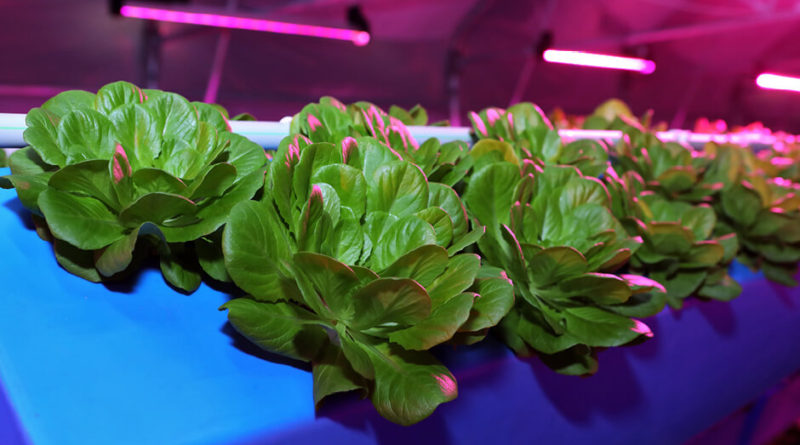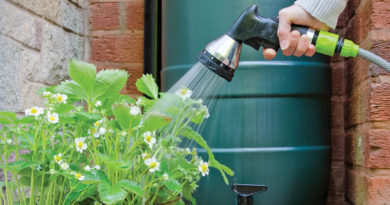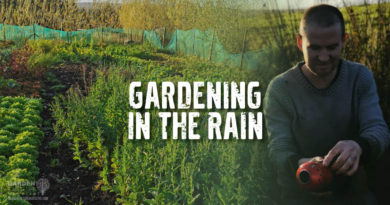Advanced Aeroponics: A Comprehensive Guide
A basic, comprehensive approach to aeroponics begins with a distinction between aeroponics and hydroponics. Hydroponic plants grow using a medium other than soil. Aeroponic plants grow with no medium — their roots simply hang in the air. They only need an anchor, such as a net pot or small stonewool cube, secured by a lid, and a misting chamber. With these and a few other items from your favorite grow store, you will be on your way to growing big with aeroponics!
The important thing with trying out new methods of gardening is to be aware of the risks. The saying, “with great risk comes great reward” applies here. If you give your plants and their roots the environment they want, aeroponic systems can be wildly successful.
Setting Up an Aeroponic System
Start with good grow lights and a climate-controlled room. Temps matter more than ever with aeroponics because although plants grow bigger and faster, they are also more susceptible to environmental stresses. The saying “more risk, more reward” rings true, more so with aeroponics than any other style of growing. However, when basic parameters such as temperature and humidity are well controlled, plants really take off with aeroponics! Crop turnover times are minimized and yields are maximized.
Email Newsletter
Join thousands of other growers who are already receiving our monthly newsletter.
Use lights manufactured specifically for growing. Begin with a well-lit, climate-controlled room. Build it the same as if growing with any method. Next add the grow system. This will consist of a root chamber, pump, misting nozzles or spray manifold, trellis, and, of course, nutrients.
 An example of an aeroponic tower garden.
An example of an aeroponic tower garden.
Choose your favorite brand of nutrients, just as you would with hydroponics, but remember aeroponics can uptake more nutrients when roots are really thriving. In this case, be sure not to burn plants by starting at half or three-quarter strength. Maintain cool water temps, which prevents problems with pathogens and disease. Generally, keeping ambient room air temps below 75°F will suffice. Target a humidity range of 35-55 percent. Place aeroponic pumps on a timer to allow a well-aerated, humid environment for the roots. Common aeroponic timer settings are on for about one-quarter to one-third of the time they are off (for example, 1 minute on, 3-4 minutes off, or 5 minutes on, 15-20 minutes off). These settings can be adjusted as desired, depending on other factors such as humidity or stage of growth.
The equipment for growing aeroponically is the same as any hydroponics room, except the plants are held in place on a lid by a net pot, as the roots are allowed to dangle and grow freely in a humidity-controlled root chamber. A trellis supporting the plants from above will also help to allow for large growth and heavier fruits. A quick internet search will yield many DIY aeroponics plans and projects available for studying. Don’t get overwhelmed with the more intense projects. Although fun for some, if that’s not your thing, start with a basic setup. Rely on the equipment mentioned above, available from your favorite grow shop, and just get going! Give your plants what they need and they will thank you.
 Aeroponic plants grow with no medium — their roots simply hang in the air.
Aeroponic plants grow with no medium — their roots simply hang in the air.
Troubleshooting Aeroponics
If aeroponic plants begin to slow their growth and vigor, this is the first sign of the need to pay closer attention.
Start with the environment first. What are the temperature and humidity levels? What is the pH level of the water? Depending on the type of plants being grown, pH levels should be maintained in a range between 5.7 and 6.5. Remember that with aeroponics, there is no soil or other grow medium to act as a buffer. While adjusting, most growers target a pH of about 6.0. Again, check the needs of your specific crop. Are the above parameters providing the plants with the environment they need to grow? Usually, one of these can easily be adjusted to correct most crop problems.
(Read also: 5 Key Things Newbie Hydroponic Growers Tend to Overlook)
As with any style of growing, be on the lookout for common garden issues, and especially keep a close eye on the roots. They need to be healthy and thriving at all times in order to maximize benefits offered from aeroponics. Roots beginning to rot will brown and develop a slimy coating, with the leaves quickly losing their vigor.
Discoloration can also occur when using certain nutrients that have a tint to their color, such as humic or fulvic acids and organically mixed nutrients. For this reason, coloration is not as important of a factor as general plant health and vigor. This can be seen by observing the ends of the roots to verify they are healthy and growing new tips that are able to easily uptake water and nutrients.
General environmental control equipment will usually prevent these types of problems.
 Roots beginning to rot will brown and develop a slimy coating, with the leaves quickly losing their vigor.
Roots beginning to rot will brown and develop a slimy coating, with the leaves quickly losing their vigor.
Maintaining a Healthy Aeroponic System
Maintaining a healthy aeroponic system can be achieved by keeping a sterile reservoir and grow system, or by inoculating and maintaining a population of beneficial biology into the reservoir and grow system. Both of these methods will maintain a healthy system even though they are virtually opposite from one another.
In a sterile system, growers use a cleaning solution between feedings to keep things clean. This is easily accomplished with little effort by continuing to run the system after harvest. Instead of nutrients and cool water, use warm water with a little hydrogen peroxide, enzymes, or other similar product. Doing so prevents the cake-up of old nutrients, which later break off into tiny pieces that clog your equipment up when you need it most, right as the next crop is starting to thrive.
On the other end of the spectrum is the inoculation of good biology to prevent the bad biology from getting started. When there are beneficial fungal spores and bacteria present, they compete with the bad bacteria for the same food. They can easily take a strong hold and prevent the bad biology from ever growing.
Whether you’re using a sterilization method or inoculating with good biology, the bad biology must be kept at bay one way or another. If it is not, it is only a matter of time until the system is contaminated and plants begin to suffer. This is why it is extra critical to maintain correct water temperatures and prevent the kind of environment bad biology can thrive in.
Cloning Using an Aeroponic System
To have consecutive successful runs in an aeroponic cloner, you need to thoroughly clean the cloning system in between each run. The cleaning process is often overlooked and a likely cause of most problems.
Over time, neoprene inserts begin to accumulate unwanted pathogens and should be replaced. Another thing to pay close attention to is water temperature. As mentioned previously, bad things grow in water above 64°F.
Internal pumps often overheat the water, so use a timer to allow the pump to cool. Be sure the area surrounding the stems where the roots will eventually grow is kept relatively humid.
Another easy way to cool down your submersible-pump system is to add frozen water bottles, which act as ice cubes to cool the water.
There are also more technical options, such as external high-pressure aeroponic pumps and misting nozzles, which allow for further control of the fine water droplets as they are delivered to the fragile cuttings.
During aeroponic cloning, the stems must be kept wet to allow for proper root development. As roots develop, you should be increasing your spray times.
After roots are 3-4-in. long and have begun to branch out, dialing back spray times will allow for increased root development, as well as prevent problems arising from root rot, which is usually brought on by overwatering.
Growing Until Harvest
Growing plants for extended periods of time in an aeroponic system is often challenging. Just as plants can grow more rapidly, things can also take a turn for the worse more quickly when compared to other methods of growing.
In other words, plants perform better when things are going right but are far less forgiving when things go wrong. For this reason, many aeroponic gardeners use the sea of green (SOG) method, which means they prefer growing small, uniform plants that make up what looks like a sea of green.
Growing shorter plants allows for faster crop turnover, further accentuating the benefit of increased growth rates achieved by aeroponics.
(Read also: The Best Hydroponic Systems for Space Optimization)
Whether you’re growing small or large plants, aeroponically grown plants must be pampered and remain happy throughout the entire process to maximize yield and quality. Many expert aeroponic growers will reduce their spray times to mimic nature and seasonal changes.
For example, in the early stages of growth, growers are mimicking the springtime, as plants want more water. As vegetative growth occurs more rapidly, the plants will have increased transpiration rates, requiring more water.
Later in a plant’s life cycle, it will begin to drink less water. Notice how in late summer and early autumn there is typically less rainfall than there was in the spring?
The plants are now ripening and not growing as aggressively as before. So, spraying the roots for shorter ON times and keeping the same OFF times, or perhaps even slightly increasing OFF times as the harvest begins to ripen will provide plants with the moisture they need and prevent issues that occur with overwatering.
Low-pressure Aeroponics
Low-pressure aeroponic (LPA) systems use submersible, pond-style pumps that move a large volume of water at a low pressure. Usually these set-ups use 360-degree spray nozzles and a manifold. Some LPA systems use a sprinkler-style product made of tubing with holes cut in it.
Critics of LPA call it a version of nutrient film technique or shallow water culture, a.k.a. recirculating hydroponics. In a way, each comparison is true, but this style of growing is indeed aeroponics. After all, there is minimal amounts of medium in the small net pots, which only act as an anchor for the plant. Roots are still hanging in the air within the root chamber and being sprayed with water.
High-pressure Aeroponics
High-pressure aeroponics, a.k.a. fogponics, uses external pumps that create a fine mist and much smaller water droplets. These droplets are in the 30-80-micron range—the ideal size for nutrient delivery, as determined by NASA researchers aboard the International Space Station during their experiments growing aeroponic potatoes in the late ’90s. Misting cycles are more precisely controlled with repeat cycle timers to provide roots access to more oxygen.
Fine hairs called trichoblasts appear off the spider webs of roots, increasing their surface area and nutrient-uptake capabilities.
Critics note that if systems are not maintained, nozzles often clog and high temperatures cause the most stress in high-pressure systems when compared to other aeroponic systems. Following the proper cleanup procedures and setting yourself up for success will address these challenges and provide the full benefits of this system.
(Read also: Fogponics: A New Spin on Aeroponic Gardens)
Cleaning an Aeroponic System
Remember to clean your system thoroughly after each crop to prevent gunked-up equipment. Prevent headaches with little effort by planning ahead and using these simple cleaning steps.
After removing plant material and debris, clean the room thoroughly. Sweeping, mopping and spraying off the walls with a light bleach or peroxide solution is good practice. Next, all the gunk needs to be removed thoroughly from the system and the reservoir.
You’ll need to apply a bit of elbow grease for this step. It is also important to clean the tubing, nozzles, manifolds and pumps. A good method is to run hot water with hydrogen peroxide through the system, which purges it of any growth inside the lines. After the system is free of nutrient buildup and other debris, repeat this process at least one more time to ensure the system is completely flushed, and then power down and let the system dry out.
In controlled environment agriculture, growers must manipulate as many parameters as possible to maximize crop performance. Aeroponics offers cultivators more controlled nutrient and oxygen delivery than any other style of growing.
Although aeroponics may require more maintenance and attention to detail, the potential for increased efficiency, quality, yield and growth rates makes it a fun, rewarding gardening method with a bright future.
Final Thoughts
Remember when starting aeroponics to have fun with it! Just get a kit, system, or parts and follow the steps laid out in this article. The rest is not much different than hydroponics or other styles of growing. Aeroponics works great from seed or clone to harvest. Just follow these steps to get growing today. Happy gardening!




